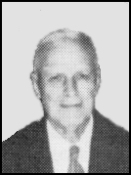

1887-1972 |
 |
 |
|
Early Birds at Cedar Point, Ohio on the occasion of the Curtiss flight commemoration. The plaque there is in good
condition today. Shown flanking the Curtiss plaque are Lawrence M. Allison, George Page, Stanley Vaughn, George H. Scragg, L. L. Custer, and Reinhardt Ausmus. |
 |
|
Photo of postcard courtesy of Roger Harvey of thepostcard.com Card Source - The Postcard Place |
|
The careers of Glenn Curtiss and Captain Thomas S. Baldwin were interwoven from the time when "Cap" first adapted Curtiss engines to his airships and began to experiment them. Their association had continued up to their mutual interest in the Atlantic Coast Aeronautical Station. Since Captain Baldwin was in charge there and always on hand, we got to know him better than Glenn Curtiss who only came to the school occasionally, but his visits always caused a stir of excitement and speculation over what new plans those two had for the school, and what famous person would show up for the next training class. THE DAY THE AIRMAIL BEGAN Cub FlyersEnterprises Inc. |
|
You will find the story of the meeting by clicking on: Stanley Vaughn |
|
via email from Stanley I. Vaughn III, 2-21-08 My grandfather started out working for Curtiss at the New York and Hammondsport facilities (NC-4 flyiing boats, Curtiss racers, etc.) as factory manager. During his tenure at New York, a young aviator landed at the airfield, ready to attempt a trans-atlantic flight to Paris. Upon his arrival, he noticed that the aluminum spinner on his aircraft had developed a fatigue crack, and requested the Curtiss folks to fix it. My grandfather rounded up some sheet metal people, and had them make a hand made a new spinner. The aviator was, of course, Charles Lindbergh, who autographed the original spinner and presented it to my grandfather. My grandfather became lifelong friends with Lindbergh, along with other aviation notables such as Foster Lane, George Page, Roscoe Turner, Jimmy Doolittle, General Lahm, etc. Being exposed to such greats seemed normal for me while growing up. My grandad went on to be the factory manager at Curtiss Buffalo (JN-4D, P-40, etc.), then went to Curtiss Columbus (SOC3-1, SB2-C, B-29 retrofit, P-87, etc.) He finished his career with North American Aviation as head of the experimental division (F-86, FJ-1, FJ-3, F-100. God Bless, Stanley I. Vaughn III |
|
via email from Stanley I. Vaughn III, 2-19-08 Thank you for maintaining this website, and for displaying the biography of my grandfather. I was blessed to know him well, since he lived up to my 17th birthday. I am possession of his (as well as my father's) archives, which are considerable. A few years ago, I assisted Peter C. Smith, the famous British aviation author, in compiling an extensive history for his book on the Curtiss SB2C Helldiver, featuring my grandfather's role in its development and manufacture. You may be also interested to learn that my father, Stanley I. Vaughn Jr., became the head of Engineering Flight Test for North American Aviation, and just passed away last year at the age of almost 90. God Bless!!! Stanley I. Vaughn III Editor's Note: The book mentioned is Curtiss SB2C Helldiver (Crowood Aviation) (Paperback) by Peter C Smith (Author) |
 |
|
Stanley I. Vaughn, Sr. died Wednesday, March 9, 1972 at his home in Columbus, Ohio. He was 85 He first flew a glider down a hill near Cleveland in April 1907. After that he worked on dirigibles and made his first flight in one near Toledo in 1909, ending in near disaster ini the Maumee River. A few years later Vaughn built and flew his own airplane. He soon went into the business of building them for the Curtiss Airplane Company. During World War II, he went to Columbus as manager for the Curtiss Wright Co. and stayed on when North American Aviation took over the plant. He retired in 1957. He is survived by his wife, a son, Stanley Vaughn, Jr. and two grand children. January 1973, |


|